
Sounds
from Amateur Radio Satellites 2023-today |
 
|
|
This section is dedicated
to satellites built and operated by Radio Amateurs.
Satellites built by AMSAT organizations around the world
and were called AMSAT-OSCAR. Those built by Russian
Hams and were mostly called Radiosputnik. In order to
build and launch the satellites AMSAT needs members
and friends to contribute and raise funds. If you are
not yet a member of AMSAT please consider to join us
and to support the activities. You can find several
links to AMSAT on my links page. |
My special
thanks to Roy W0SL, Jim N4ST, Don KD4APP, Darrel AA7FV,
Jim N5JDB, Clive G3CWV, Mike DK3WN, Reinhard DJ1KM +,
Michael DG1CMZ, Oliver DG6BCE, Peter DF2JB, Volker DF7IT,
Jean-Louis F6AGR, Thomas HB9SKA, Christoph HB9HAL, Claudio
IK1SLD, Andreas OE1DMB, Michael PA3BHF, Henk PA3GUO,
Darek SP9TTX, Ricardo PY3VHQ, Keith ZS6TW, Don N4UJW,
Vladimir RA3DQT, Paulo CT1ETE, John KD2BD, Harald DH8HHA,
Maik Hermenau, Ian ZL1AOX, Gerd DL8DR, Michael OH2AUE,
Robert G8ATE, Wouter Jan Ubbels PE4WJ, Mark KF6KYI,
Al W8KHP, Drew KO4MA, Rolf DK2ZF, Dave WB6LLO, Graham
G3VZV, Joe K0VTY, Nils von Storch, Zeljko 9A2EY, Pierre
ZS6BB, Bent OZ6BL, Mariano CT1XI, Al GM1SXX, Luc LU1FAM,
Matt SQ7DQX, Lance K6GSJ, Chris VK3AML, Bob VE6BLD,
Sergej RV3DR, Alex VK5ALX, Rudolf ZS6FX, Dick Daniels
W4PUJ/SK , Bob Patterson K5DZE, Jean-Louis Rault F6AGR,
Ivano Bonesana, Patrick Hajagos, Luc Leblanc VE2DWE,
Mike N1JEZ, John K6YK, Tetsu-san JA0CAW, Marco Bauer,
Carl Lindberg SM6NZV, Philip G0ISW, Kuge-san JE1CVL,
Pat AA6EG, John M0UKD, Paul Marsh M0EYT, Federico Manzini,
Jan PE0SAT, Domenico I8CVS +, Roland Zurmely PY4ZBZ,
Rob Hardenberg PE1ITR, Michael Kirkhart KD8QBA, Davide
D'Aliesio IW0HLG, Francisco EA7ADI, Kubota-san, Noguchi-san
JA5BLZ, Kuge-san JE1CVL, Luciano PY5LF, Wakita-san JE9PEL,
Peter ON4EZJ, Enrico IW2AGJ, Jean-Pierre F5YG, Remco
PA3FYM, Dave G0CER, Jose Maria EA2JX, Viljo ES5PC, Charly
DK3ZL, Bernd DL6IAN, Gustavo LW2DTZ, Juergen DL8SDQ,
Gary ZS6YI, Wilhelm DL6DCA, Bence Szabo, Alex KR1ST,
Branko 9A3ST, Daniel DL7NDR, Michael Hoerenberg, Igor
PU4ELT, Tom SP5LOT, Nina DL2GRC and Udea san JA0FKM
for kindly contributing to this collection ! |
Picture |
Satellite
#NORAD |
Description |
Launch Date |
 |
SO-120
Spain-OSCAR 120
URESAT-1
HADES-B
HADES-2
#56992
(2023-084bu) |
URESAT-1 is a 1.5P
PocketQube (8x5x5 cm) picosatellite developed by AMSAT
EA. HADES-B was launched with SpaceX on
June 12th 2023 (Transporter-8
mission from Vanderberg).
The satellite was
expelled from the D-Orbit Orbital Transfer Vehicle (OTV)
ION ten days after the launch, on June 22nd
at 12.10 UTC, along with MRC-100 and ROM-2 satellites.
Unfortunately the satellte had
a problem with the deployment of the antennas and thus
only stations ith larger antennas were able to receive
its downlink (telemetry, CW and SSTV).
It
is a mission which offers radio-amateurs around the
world the opportunity to relay FM voice and AX.25 /
APRS 300/1200 bps communications. This is achieved by
implementing a SDR based FM and FSK repeater. A SSTV camera module
by Brno University is expected to fly depending on time
restrictions. Images would be taken in a random way.
The SSTV module would contain some ROM coded images
to be transmitted as well. URESAT hardware and software
subsystems are enhanced ones of the previous AMSAT-EA
HADES.
I am searching for sound files. Please
send them to
 |
Jun 12th
2023 |

|
SO-121
Spain-OSCAR 121
HADES-D
#58567
(2023-174cy) |
HADES-D
was launched into space on the SpaceX TR-9 mission dated
November 11, remaining in orbit inside the orbital transfer
vehicle (OTV) ION-SCV-013 from D-ORBIT until the 18th
when said 'mother satellite' ejected it, at 7:53 UTC.
The
repeater works with FM/FSK (MSK144 has been tested too)
with
an uplink frequency of 145.875 MHz and a downlink frequency
of
436.6635 MHz (a bit lower than the 436.666 MHz expected).
We have
been able to verify that the modulation is more appropriate
by narrowing
the bandwidth, so it is recommended to use NFM in those devices allowing
it.
HADES-D
is the first satellite with FM repeater service mounted
on a
pocketqube platform. This standard is the smallest in
terms of normalized
satellite sizes. HADES-D size is 8x5x5 cm. Its panel
surface
and battery size are much smaller than the rest of the
satellite
repeaters in use, so HADES-D is not comparable to most
of them
either in radiated power or signal strength. HADES-D should be
considered a QRP satellite. |
Nov
11th 2023 |
 On November
28th 2023 at 21:14 UTC Daniel
DL7NDR received on 436.666 MHz the voice beacon. Recording
kindly provided by Daniel DL7NDR. On November
28th 2023 at 21:14 UTC Daniel
DL7NDR received on 436.666 MHz the voice beacon. Recording
kindly provided by Daniel DL7NDR.
|
 On November
29th 2023 around 10:15 UTC
Daniel DL7NDR received on 436.666 MHz the FSK50 beacon.
Recording kindly provided by Daniel DL7NDR. On November
29th 2023 around 10:15 UTC
Daniel DL7NDR received on 436.666 MHz the FSK50 beacon.
Recording kindly provided by Daniel DL7NDR.
|
 On December
3rd 2023 around 10:55 UTC Daniel
DL7NDR received on 436.666 MHz the FSK50 beacon. Recording
kindly provided by Daniel DL7NDR. On December
3rd 2023 around 10:55 UTC Daniel
DL7NDR received on 436.666 MHz the FSK50 beacon. Recording
kindly provided by Daniel DL7NDR.
|
 On January
7th 2024 around 09:35 UTC Daniel
DL7NDR received on 436.666 MHz the FSK50 beacon. Recording
kindly provided by Daniel DL7NDR. On January
7th 2024 around 09:35 UTC Daniel
DL7NDR received on 436.666 MHz the FSK50 beacon. Recording
kindly provided by Daniel DL7NDR.
|
 On August
23rd 2024 at 10:52 UTC Daniel
DL7NDR received on 436.666 MHz the CW beacon. Recording
kindly provided by Daniel DL7NDR. On August
23rd 2024 at 10:52 UTC Daniel
DL7NDR received on 436.666 MHz the CW beacon. Recording
kindly provided by Daniel DL7NDR.
|
 Igor PU4ELT received
the CW beacon of SO-121 on September 12th 2024
at 13:29UTC. Recording kindly provided
by Igor PU4ELT. Igor PU4ELT received
the CW beacon of SO-121 on September 12th 2024
at 13:29UTC. Recording kindly provided
by Igor PU4ELT.
|
 On May
14th 2024 at 13:36 UTC Igor
PU4ELT made a successful 2-way FM contact via SO-121
with PU5UEL. On May
14th 2024 at 13:36 UTC Igor
PU4ELT made a successful 2-way FM contact via SO-121
with PU5UEL.
|

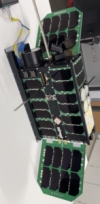
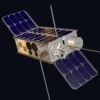
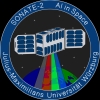
|
SONATE-2
DP0SNX
#59112
(2024-043Q) |
The
SONATE-2 mission will verify novel AI hardware and software
technologies in miniaturized format in LEO. The satellite
will be able to analyze the environment autonomously
with its multiple sensors in visible and near infrared
spectrum and train its neural networks in space to detect
anomalies.
During passes over
the ground stations in Germany the telemetry downlink
will be activated. Frequency: 437.025
MHz, Modulation: 9k6 G3RUH GMSK (F1D), Protocol: AX.25
The CW Beacon is
only sporadically used. Mainly during LEOP for launch
object identification. If activated, a beacon with the
callsign of the satellite DP0SNX is transmitted at regular
intervals as CW Morse code. Frequency: 145.840 MHz,
Modulation: Morse code CW (A1A), Interval: 30 sec
The APRS digipeater
on SONATE-2 operates in half-duplex operation. The digipeater
is only active when published below. When activated,
it will transmit a greeting message every 2 minutes.
Make sure to include SONATE-2's callsign DP0SNX in the
APRS route. Frequency: 145.825 MHz Up/Down, Modulation:
1k2 AFSK (F2D), Protocol: AX.25, TX Power: 500mW
Regular downlinks
of SSTV images captured by SONATE-2's on-board cameras
are planned. The SSTV downlinks are only active during
the times when published below. Only a single images
is transmitted at the specified timestamps (all in UTC).
Frequency: 145.880 MHz, Modulation: Martin M1 SSTV FM
(F3F), TX Power: 500mW
I am searching for sound files. Please
send them to
 |
March 4th
2024 |
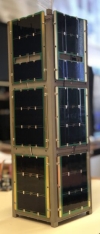
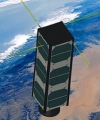
|
MO-122
MESAT-OSCAR-122
MESAT-1
Maine Satellite 1
#60209
(2024-125G) |
On
July 4th 2024
at 04:04 UTC, the MESAT 1 satellite was launched on
a Firefly Alpha launch vehicle from Vandenberg Space
Force Base in California. Developed by the University
of Maine, the 3U Cubesate carries an earth imaging experiment
and an AMSAT-provided LTM-1 linear transponder to provide
services to amateur radio enthusiasts around the world.
The
spacecraft also carries an L-band BPSK GlobalStar transmitter
with a carrier frequency of 1616.25 MHz. This will be
used along with the onboard GPS receiver, to provide
early mission TLEs.
The frequencies
of MESAT-1 are:
Transponder:
Uplink
145.910-145.940
MHz
Downlink 435.810-435.840
MHz
Beacon:
435.800
MHz 1200bd BPSK
The satellite has
been commissioned and the transponder is currently active.
I am searching for sound files. Please
send them to
 |
July 4th
2024 |

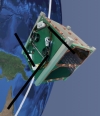
|
CosmoGirl-Sat
Emma
JS1YOI
#60953
(1998-067WT) |
CosmoGirl-Sat (JS1YOI)
is a cubesat 1U from the Cosmo Women’s Amateur Radio
Club in Japan. It was brought to the ISS on SpaceX's
CRS NG-21 mission on August 4th 2024
and was released from the ISS on August 29th 2024
at 09:45UTC along with 3 other satellites including
the Sakura (Grees 03).
CosmoGirl-Sat transmits
on the following frequencies:
473.120
MHz CW + GMSK 4k8 AX.25
145.825 MHz APRS digipeater
AFSK 1k2 |
Aug.
29th 2024 |
 Igor PU4ELT received
the CW signal of CosmoGirl-Sat on August 29th 2024
at 14:36UTC, only 5 hours after its release from the
ISS. Igor PU4ELT received
the CW signal of CosmoGirl-Sat on August 29th 2024
at 14:36UTC, only 5 hours after its release from the
ISS.
|

|
SAKURA
Grees 03
Gardens 03
#60954
(1998-067WU) |
SAKURA is a 1U cubesat
built by the Chiba Institute of Technology, a university
in Narashino, Japan. The satellite carries two cameras
designed to monitor sunspots and solar flares, as well
as to assess environmental damage on earth. It also
includes Amateur Radio transmitters on 145.825
MHz and 437.375 MHz. The modes include an 1200bd APRS
digipeater on VHF and a 4800bps GMSK as well as CW beacon
on UHF. |
Aug.
29th 2024 |
 Igor PU4ELT received
the CW signal of SAKURA using the callsign JS1MYM on
August 29th 2024
at 14:36UTC, only 5 hours after its release from the
ISS. Igor PU4ELT received
the CW signal of SAKURA using the callsign JS1MYM on
August 29th 2024
at 14:36UTC, only 5 hours after its release from the
ISS.
|
 On August
30th 2022 at 04:05 UTC Daniel
DL7NDR received on 437.375 MHz the CW beacon. Recording
kindly provided by Daniel DL7NDR. On August
30th 2022 at 04:05 UTC Daniel
DL7NDR received on 437.375 MHz the CW beacon. Recording
kindly provided by Daniel DL7NDR.
|
  On August
30th 2022 at 04:09 UTC Daniel
DL7NDR received and decoded on 437.375 MHz the CW beacon.
Recording kindly provided by Daniel DL7NDR. On August
30th 2022 at 04:09 UTC Daniel
DL7NDR received and decoded on 437.375 MHz the CW beacon.
Recording kindly provided by Daniel DL7NDR.
|
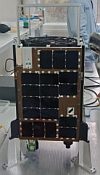
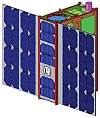
|
AO-123
ASRTU-OSCAR 123
ASRTU-1
Druzhba
ATURK
RS64S
#99130
(2024-099A) |
ASRTU-1
was launched on November 4th 2024 at 23:18 UTC,
on a Soyuz launch vehicle from Vostochny Cosmodrome,
Russia. The 12U satellite was built and is operated
by Harbin Institute of Technology and Amur State University
in China. It carries a V/U repeater, UHF SSDV digital
image transmitter, and a 10.5 GHz QPSK image transmitter.
All of these payloads have been successfully tested,
and the repeater has been operational for QSOs. It uses
the callsign BJ2CR.
The
satellite contains an FM transponder, which is currently
operational, with an uplink of 145.850 MHz (67 Hz CTCSS
tone required) and a downlink of 435.400 MHz. After
the repeater detects the end of uplink, it will wait
for 0.5s. If no new uplink in 0.5s, telemetry will be
sent. So make fast QSOs so the telemetry is less like
to interrupt you.
The
satellite also contains two cameras with an SSDV downlink
for low resolution images on 436.210 MHz, and a high
speed downlink on 10.460 GHz for high resolution images. |
Nov.
4th 2024 |
 On November
17th 2024 PU4ELT and PU4TDC
had a brief contact using the FM Transponder of AO-123
. Recording kindly provided by Igor PU4ELT. On November
17th 2024 PU4ELT and PU4TDC
had a brief contact using the FM Transponder of AO-123
. Recording kindly provided by Igor PU4ELT.
|

|
BGS
ARPIT
POEM-4
UCVR-0643-6863-2318-5100
#62461
(2024-253C) |
BGS
ARPIT is an Indian Amateur Radio payload jointly developed
by SJCIT, UPARC (Upagrah Amateur Radio Club-VU2URC)
& AMSAT-INDIA. It was launched on December 30th
2024 by India's PSLV C-60 launch vehicle. This payload
is fastened to the last stage of the PSLV engine. This
last stage of PSLV is often used as an 'Experimental
Platform' called 'POEM' (PSLV Orbital Experimental Module).
This is the 4th such experimental
module. Since December 31st
2024 BGS ARPIT is switched on only over India and since
January 9th 2025 also over
Europe. The team has received very good and encouraging
signal reception reports of the Amateur Radio downlink. |
Dec.
30th 2024 |
  On January
9th 2025 at 11:30h UTC SP5LOT
received the NFM
downlink signal from BGS ARPIT on 145.870MHz. Enclosed
recording includes the pre recorded audio
message, a greeting message & limited Telemetry
in APRS packet format and a pre loaded SSTV Image. Recording
and decoded SSTV image kindly provided by Tom SP5LOT. On January
9th 2025 at 11:30h UTC SP5LOT
received the NFM
downlink signal from BGS ARPIT on 145.870MHz. Enclosed
recording includes the pre recorded audio
message, a greeting message & limited Telemetry
in APRS packet format and a pre loaded SSTV Image. Recording
and decoded SSTV image kindly provided by Tom SP5LOT.
|
 |
SO-124
SPAIN-OSCAR 124
HADES-R
SmartSat
#62xxx
(2025-009xx) |
The
HADES-R amateur radio satellite was built by Hydra Space
Systems S.L. and is operated by AMSAT-EA. The 1.5u Pocketqube
was
successfully deployed on January 22nd at 15:42 UTC from
the D-Orbit ION-SCV-016 orbital transfer vehicle (OTV)
after launching on January 14th aboard a SpaceX
Falcon 9 rocket as part of the Transporter-12 mission
from Vandenberg Space Force Base.
Transmissions
started shortly after deployment, though its FM repeater
remains inactive as testing and validation processes
continue. According
to AMSAT-EA’s update on January 23rd, the satellite
is transmitting telemetry data, and the initial health
reports indicate that it is in good condition. The team
is actively receiving data and preparing to transition
the satellite into repeater mode once all necessary
checks are completed. Amateur radio operators worldwide
are encouraged to share their telemetry reports to assist
in confirming its operational status.
Designed
to provide FM voice repeater capabilities, the satellite
also supports various digital modes, including FSK telemetry
and APRS at up to 1200 bps. It features a downlink frequency
of 436.888MHz, as coordinated by the International Amateur
Radio Union (IARU). While FM voice is its primary mission,
it willalso transmit experimental data and FSK telemetry
as well as a CW beacon. The uplink frequency is 145.925MHz,
supporting FM voice and various digital modes, including
AX.25 and APRS. The FM repeater, which was activated
on February 19th 2025, is operating
without requiring a subtone, activating via squelch
level.
I am searching for sound files. Please
send them to
 |
Jan 14th
2025 |
 |
SO-125
SPAIN-OSCAR 125
HADES-ICM
#63492
(2025-009xx) |
The HADES-ICM amateur
radio satellite was built by Hydra Space Systems S.L.
and is operated by AMSAT-EA. The 1.5u Pocketqube was
launched on a SpaceX Falcon 9 rocket on March 14th 2025.
Its main mission
is to act as a FM voice repeater. It can also repeat
FSK derived modes like FT-4 and FT-8. As
there is a small empty space available, it will be used
to carry an experiment by Smart IR/Graphene Engineering
Innovation Centre, GEIC University of Manchester (UK)
consisting in a very low power active radiator to be
tested on space conditions. The data for this experiment
will be transmitted in a specific data packet in the
telemetry. This experiment is the same as the one in
HADES-R (SO-124). This experiment will be delivered
to AMSAT EA for integration and will be operated by
AMSAT-EA, being all its data public and open.
Engineering and
manufacturing support for this mission is carried out
with the help of private sector companies and universities,
but AMSAT-EA will be the only operating organization.
HADES-ICM will offer
licensed radio-amateur around the world the opportunity
to relay FM voice and AX.25 / APRS 300 / 1200 bps communications.
The coordinated uplink frequency is 145.875
MHz, and the downlink is 436.666 MHz. The repeater operates
with an open squelch and does not require a subtone.
FSK derived transmissions
and modes like FT-4 and FT-8 are also supported. As
an improvement from previous missions, maximum power
is now 0.25W when battery is charged (the amplifier
uses battery energy), allowing easier QSOs with handheld
antennas like Arrow or Elk and less sensitive receivers.
The satellite will
also transmit telemetry with its status and CW messages.
Telemetry
will send some FSK English formatted text messages,
part of a history, to be collected as a challenge. This
all will be achieved by implementing a SDR based repeater.
This satellite is
based on the hardware of HADES-D (SO-121, currently
being used by hams worldwide for voice contacts) and
the next to launch HADES-R.
I am searching for sound files. Please
send them to
 |
Mar 14th
2025 |
Picture |
Satellite
#NORAD |
Description |
Launch Date |
If you
have further recordings from space objects please let
me know. I will be happy to add them to my homepage.
Many thanks in advance.
Vy 55 & 73 de
Matthias DD1US  |


|